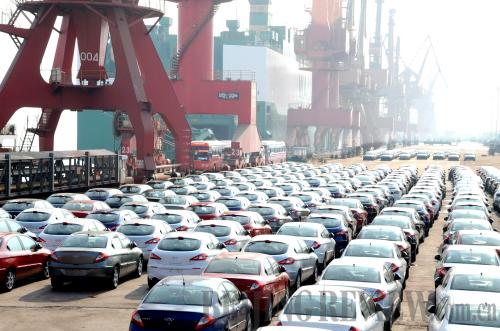|
 |
|
LONG LINES: A total of 880 cars wait to be exported to Russia at Jiangsu Province's Lianyungang Port in September 2010 (WANG CHUN) |
Boosted by the strong recovery of the domestic economy and modest growth prospects of the whole world, China's exports and imports regained powerful momentum in 2010, returning to pre-crisis levels.
Figures from the General Administration of Customs (GAC) showed exports and imports for 2010 totaled $2.97 trillion, jumping 34.7 percent year on year. Exports grew 31.3 percent last year to $1.58 trillion, while imports surged 38.7 percent to $1.39 trillion. The trade surplus was $183.1 billion, dropping 6.4 percent.
The EU, the United States and Japan remained the country's top three trading partners in 2010. China continued running a deficit with Japan, which expanded 68.5 percent to reach $55.65 billion.
China's trade activities with emerging economies flourished last year. Trade with the ASEAN, Australia, Brazil and Russia grew 37.5 percent, 46.5 percent, 47.5 percent and 43.1 percent, respectively. India became China's 10th largest trading partner, with trade volume rising 42.4 percent to reach $61.76 billion.
Zhao Jinping, a researcher with the Development Research Center of the State Council, said customs data showed China had entered a new round of growth in foreign trade after recovering from the global crisis.
Last year's rosy figures also showed the fulfillment of the Chinese Government's efforts to narrow the trade surplus and optimize industrial structure of the export sector. But despite impressive growth rates in 2010, foreign trade still faces many uncertainties in 2011.
Growth propellants
China's Ministry of Commerce (MOFCOM) recently said foreign trade last year was "better than expected."
Li Jian, a researcher with the Chinese Academy of International Trade and Economic Cooperation under the MOFCOM, said the strong growth in foreign trade was due to the recovery in global demand, government efforts to maintain export growth and the low comparison basis of 2009.
Booming overseas demand helped China's high foreign trade growth last year, said Li. Emerging economies and developing countries saw rapid recovery last year in investment and trade, and although personal consumption in developed countries picked up slowly, demand for daily necessities, especially cheap consumer goods, increased steadily.
Last year China's exports of clothing, textiles, suitcases and handbags increased 20.9 percent, 28.4 percent and 40.8 percent year on year, respectively, according to the GAC. Yiwu, a commodity hub in east coastal Zhejiang Province, realized exports of $2.6 billion in the first 11 months of 2010, rising 35 percent, said Yiwu Municipal Foreign Trade and Economic Cooperation Bureau.
Li also said that a series of effective measures taken by the Chinese Government gave export enterprises a helping hand and helped stabilize the export market. To increase the share of made-in-China products in the international market, the government extended China's industrial chain, forged economies of scale and improved the infrastructure and affiliated services of the sector.
A much lower comparison basis with 2009 was also a contributor to 2010's strong growth rates. After scoring record high trade figures in 2008 before the crisis, China's foreign trade decreased through much of 2009.
| 